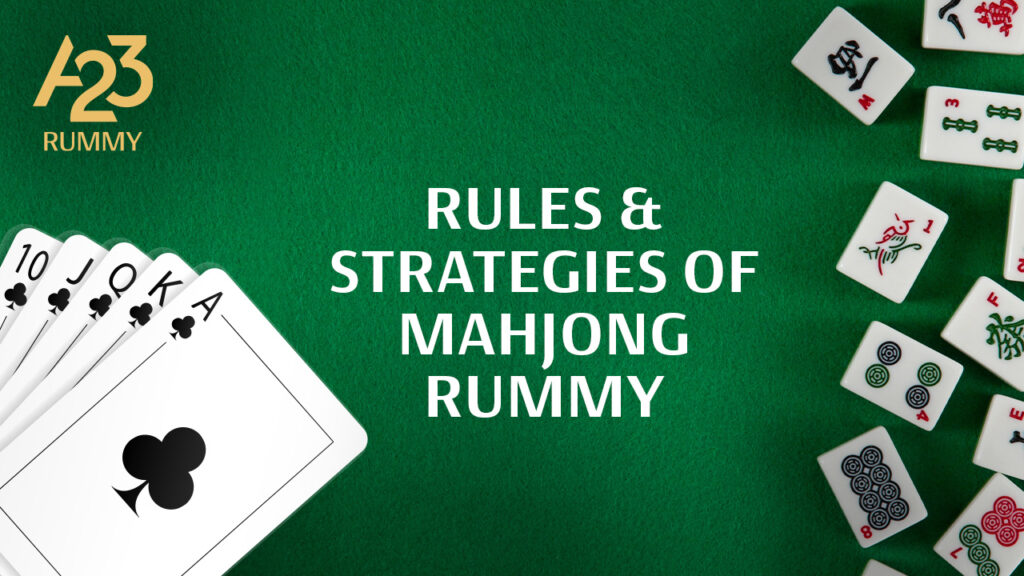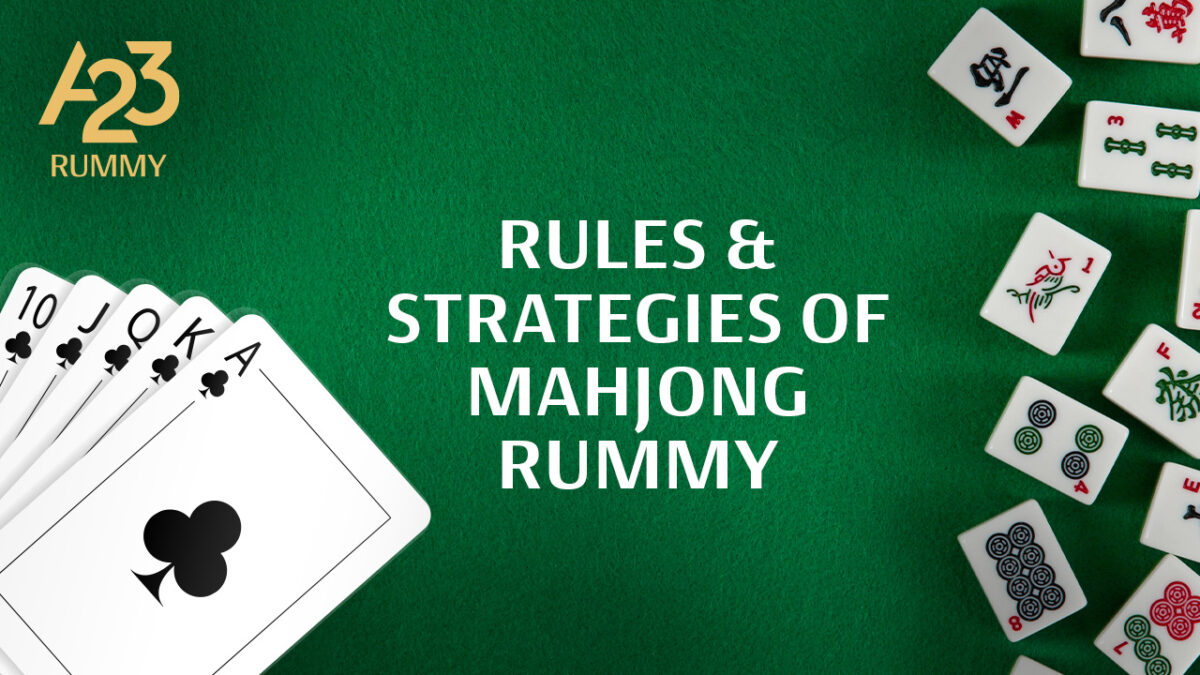
Rummy is one of the most popular card games in the world, which has inspired multiple variations like:
- Gin Rummy
- Oklahoma Rummy
- Mahjong Rummy.
Each of these variants originated from different regions around the world.
In today’s post, we’ll be talking about Mahjong Rummy. So, if you’re a beginner looking for more information on this game, continue reading below.
Understanding the Basics of Mahjong Rummy
As its name suggests, Mahjong Rummy combines the elements of the Chinese game of Mahjong and Rummy. In other words, it combines the concept of melds and runs (or sequences) and tile-centric rules.
If you do not use tiles, you can use playing cards with Mahjong tile patterns. These cards are divided into different categories and suits, like figures, bamboo, circles, flowers, Dragons, and Wind.
Number of Players and Objective
Now, a group of between three and four players can play this game. However, in case less than four players are present, the players can form extra melds to compensate for the missing player(s).
Their basic objective is to meld (or group) cards into sets and runs to win. As per Mahjong Rummy rules, you should meld your cards into at least one set and one run to win*. A set refers to a meld of cards belonging to the same rank.
*Note: You might need to use the cards that have Wind or Dragon tile designs to complete some of the melds. You can also use the Joker cards (which are treated as wild cards) to complete a set or run as per Mahjong Rummy rules*.
On the other hand, a run or sequence refers to a meld of three or more consecutive cards belonging to the same suit.
However, if you have some cards remaining in your hand at the end of the game, they are referred to as ‘deadwood cards.’ Ideally, you should have a low number of deadwood cards.
Alternatively, you can also form sets and runs in the following manner:
- Pungs – a set of three cards with the same design (such as Winds, Dragons)
- Kongs – a set of four cards with the same design (such as Winds, Dragons)
- Chows – a run or sequence of three cards belonging to the same suit
Playing The Game
Let’s now talk about how you can play a round of Mahjong Rummy in the sections below.
Setting Up The Game
A dealer is randomly selected before the game starts.
After that, he/she shuffles the deck of cards and hands thirteen cards to each player.
The remaining cards are placed face down to form the ‘draw pile’ from which you can take cards during each round in the game.
The ‘discard pickle’ is formed using the topmost card of the ‘draw pile’, and is kept face up. In a game of Rummy online, the player assigned to be the dealer presses a ‘Deal’ button, after which the algorithm randomly deals thirteen cards to each player.
After that, the draw and discard piles are automatically formed from the remaining cards.
Playing a Round of Mahjong Rummy
Let us look at the rummy rules and gameplay.
To begin the game, the player who is seated to the right of the dealer can either:
- Draw a card from the ‘draw pile’
- Take a card from the ‘discard pile’ and add one of their existing cards to it*.
*Note: You can only take the card from the ‘discard pile’ after saying ‘Rummy’ or ‘Maj’. However, there is no need to say so if you’re playing digitally.*
In online Rummy, you can draw or discard cards by pressing the relevant button.
If you manage to meld your cards into at least one set and one run, then you can ‘knock’ to declare and win the game.
Scoring System & Winning Conditions
Most online Rummy games or offline variants require the player to score the least amount of points to win. However, in Mahjong Rummy, points are calculated a little differently. The points you score will depend on the:
- Cards you have in your hand
- Numerical value of the melds (sets and runs) made by you
The value of each set or run will be different due to the varying values of the cards. Additionally, the total points you need to win will depend on which regional variant of Mahjong Rummy you’re playing.
Common Strategies for New Players
Now that you’ve learned all about the game let’s take a look at some of the strategies you need to employ to win.
Managing your tiles/cards efficiently
This tip is valid for all Rummy games that you play.
You will need to become good at studying your hands, deciding upon the possible runs and sets you can make along with the cards that you need to form the desired melds.
For example, if you have two Dragon tile cards in your hands, and the topmost card of the ‘draw pile’ has a Dragon card, you can draw that card to complete a ‘Pung.’ Alternatively, if you have five consecutive ‘Wind’-tile cards, you can discard one of them to form a ‘Chow.’
However, if you can form a run or set from your existing hand, you should do that to avoid having ‘ deadwood cards.’
Observing your opponents’ discards
We recommend carefully studying which cards your opponents discard during a round of Mahjong Rummy. In a game of online Rummy, you have to keep your eyes on the discard pile. That’s because you can get a clue regarding which run or set your opponent might be forming.
For example, if your opponent has discarded ‘Dragon’ tiles twice and drawn ‘Wind’ tiles, then they may be attempting to form a ‘Kong’ or a ‘Pung’. So, to prevent them from doing so and declaring a winning hand, you can draw the next ‘Dragon’ tile card and form your own meld.
Using Jokers and wild cards wisely
You should not underestimate the importance of using the Joker cards to complete valid sets or runs. For example, say you have an existing run of three cards already but are unable to locate a relevant card to complete your ‘Chow.’
You can use a ‘Joker card’ to complete your ‘Chow’,’ as it will be equivalent to the card you are unable to locate.
Forming High Value Melds
We would recommend you form melds with high numerical values to maximize your score. That’s because Mahjong Rummy games have a limit of thousand to two thousand points, or more, depending on the region-specific variant you’re playing.
Common Mistakes to Avoid
You should avoid making the following mistakes when you’re playing Mahjong Rummy:
Not Understanding The Rules
Yes. You should first read up on the rules of this game before you play it since you might make careless mistakes otherwise. You should also familiarize yourself with the values of all the cards to avoid melding low-value sets or runs.
Discarding High Value Cards
Since most online Rummy or offline Rummy games require players to gain low scores, players discard high-ranking cards. This leads to a lower score and their eventual loss.
Forming Low-Value Melds
As we mentioned previously, you should aim to meld high-value cards together,since low-value melds lead to lower scores and a loss.
Not Utilising Joker Cards
The Joker cards can take on the value of any card. However, some people do not trust these cards and do not use them. That’s why they cannot complete their melds, which costs them the game.
In Review
Mahjong Rummy is quite an interesting game that you can play for recreational purposes. It involves many cards, which adds to the challenge and compels everyone to try and become the best at it.
But since you’re a beginner, we recommend you first familiarize yourself with the Mahjong Rummy rules. After that, you should play multiple practice games to perfect your skills. And lastly, don’t forget to have fun during the process!





 Mar 26, 2025
Mar 26, 2025
Note: that your message will not be displayed until it is reviewed by the moderator!